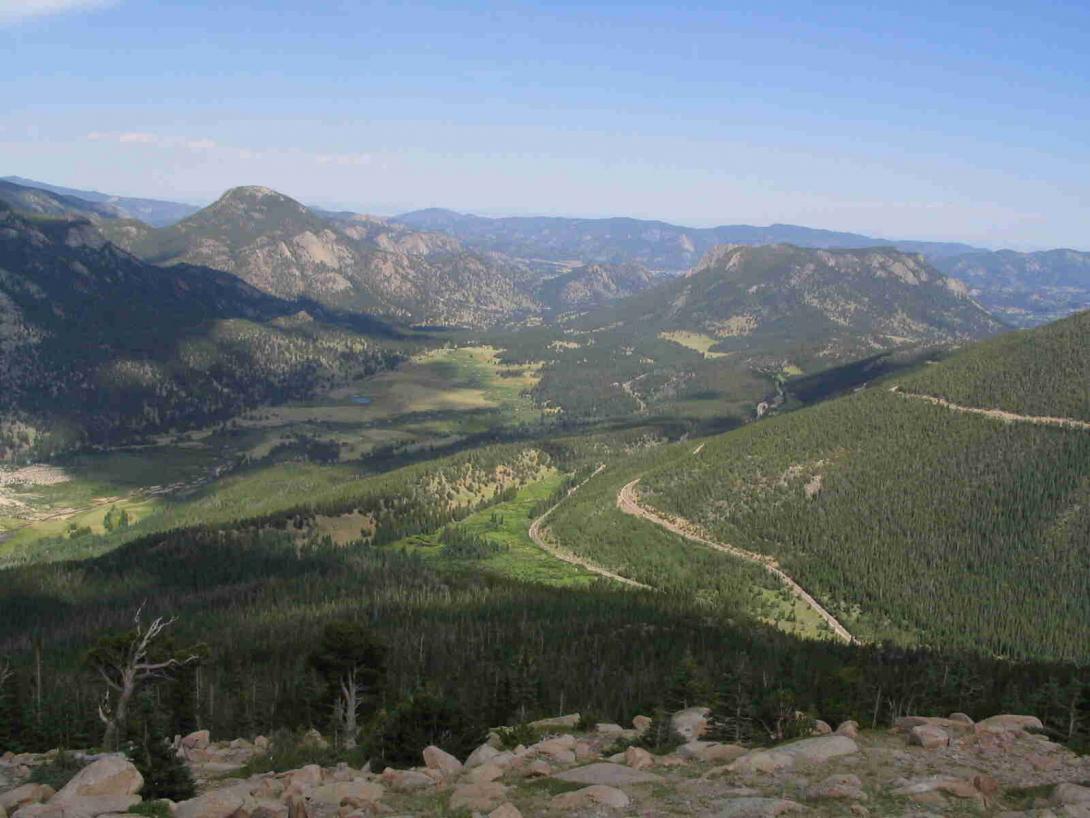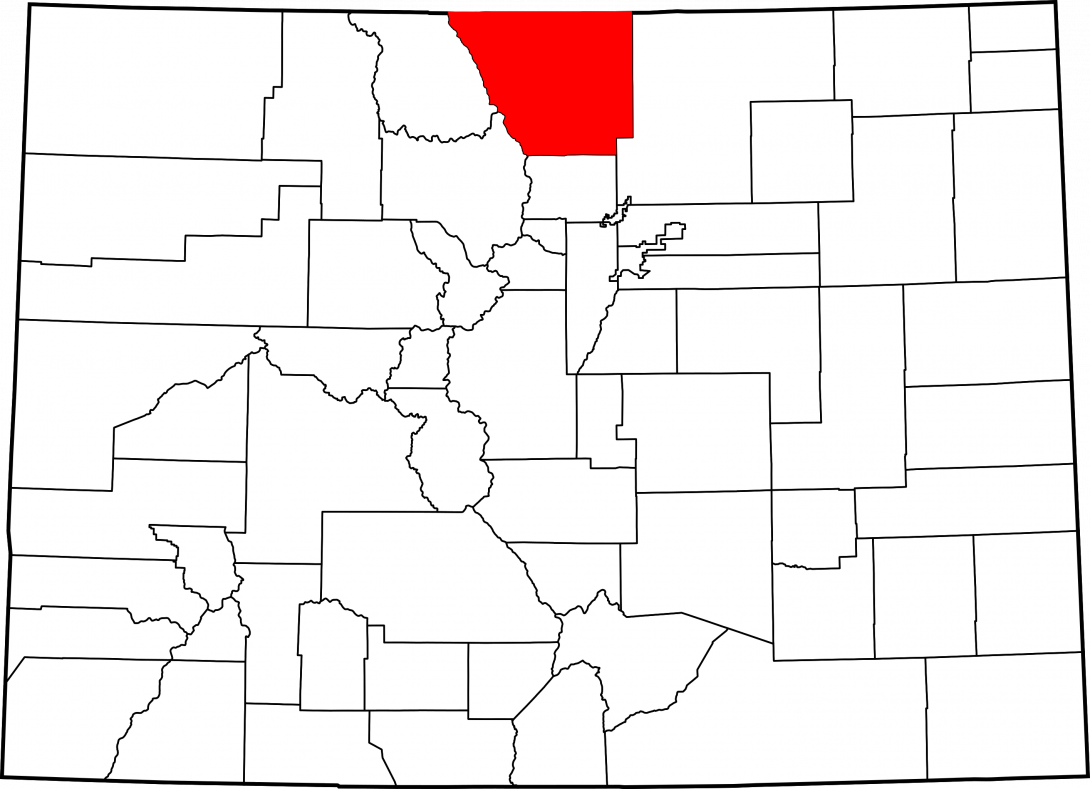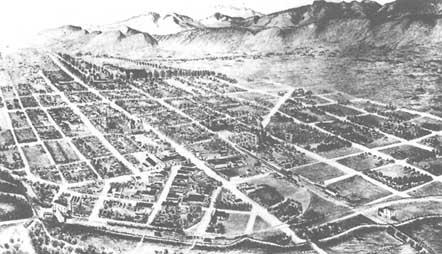Larimer County
Full Article
Located in north central Colorado, Larimer County encompasses more than 2,600 square miles of plains, foothills, and high mountains in the northern Front Range. The county shares its northern border with Wyoming and borders Weld County to the east, Jackson and Grand Counties to the west, and Boulder County to the south.
Founded in 1861 and named after Denver founder William Larimer, Jr., Larimer County contains the entire Roosevelt National Forest and the northeastern portion of Rocky Mountain National Park, as well as the scenic mountain town of Estes Park. Fort Collins, the largest city and county seat, is nestled against the foothills of the Rocky Mountains about fifty miles south of Cheyenne, Wyoming. The city is home to Colorado State University, a land-grant university founded in 1870 with funds from the federal Morrill Act of 1862. Today Larimer County supports a population of 300,000.
Native Americans
The United States acquired Larimer County’s current area in 1803 as part of the Louisiana Purchase. At that time the dominant Native American groups were the Ute, Cheyenne, and Arapaho. The Utes were mountain hunters who inhabited the area’s higher elevations, while the Cheyenne and Arapaho were nomadic equestrian hunters who lived on the plains for most of the year. On the plains, cottonwood stands along the Cache la Poudre and other rivers provided food and shelter during the scorching summers and frigid winters. The Arapaho also frequently camped in higher mountain valleys during the summer, taking advantage of abundant game such as elk, buffalo, and bighorn sheep. This often brought them into conflict with other native groups, such as the Utes, who sought the same animal resources.
Early American Era
En route to Wyoming during the mid-1820s, members of the William H. Ashley party were the first whites to explore the Cache la Poudre River valley, giving rise to one of many stories about the river's name. As this story goes, the party was halted by a snowstorm near present-day Greeley, and some members stashed gunpowder and supplies along the river. They named it “Cache la Poudre,” French for “powder cache.” However, there are multiple accounts of how the river was named, none of which have been confirmed by historical evidence.
After the Cheyenne and Arapaho agreed in the treaties of Fort Laramie (1851) and Fort Atkinson (1853) to stop raiding wagon trains, the Larimer County area was opened to white settlement. In 1859, Horace Greeley, a newspaperman and famed promoter of western settlement, visited the area and was convinced it could be irrigated to support farming. By the early 1860s, the first white farmers were already digging ditches to divert water from the Cache la Poudre, and soon afterward the first beet crops were planted. In the spring of 1870, Union Colony, an agricultural venture led by Nathan C. Meeker and financially backed by Greeley, bought and settled 9,000 acres of land near present-day Greeley. Members of Union Colony constructed the first major irrigation canal along the Cache la Poudre, and by the early 1880s there were some fifty-three canals and ditches diverting water from the river.
In 1860 Missourian Joel Estes founded the mountain settlement of Estes Park along the Big Thompson River; the town became one of the busiest tourist destinations in the state after Rocky Mountain National Park was established in 1915. In 1861, the town of Laporte, northwest of Fort Collins near the foothills, was named Larimer County’s first seat. The following year, the US Army established Camp Collins near Laporte to protect settlers on the Overland Trail from Native American raids. A flood in 1864 destroyed the camp, and the army was forced to move it to a site further downstream, where the present city of Fort Collins was plotted. Fort Collins successfully petitioned to become the county seat in 1868, and the city was incorporated in 1873. In 1877 the Colorado Central Railroad built the first rail line through the county, and the city of Loveland, named after the railroad’s president, was established along the company’s tracks some fifteen miles south of Fort Collins.
Agriculture
The Agricultural College, which later became Colorado State University, was established in Fort Collins in 1870, its research augmenting the county’s main economic driver. The sprawling, sophisticated network of irrigation ditches in operation since the 1860s allowed extensive production of wheat, corn, and—arguably the most important crop in Colorado at the turn of the century—the sugar beet. Between 1899 and 1907, sixteen sugar beet factories were built in in the state. The most prominent were those of the Great Western Sugar Company in the towns of Eaton, Fort Collins, Greeley, and Windsor.
From the late nineteenth century onward, most Larimer County inhabitants, including beet laborers, were whites of European origin. Japanese laborers also worked Colorado beet farms. At the turn of the century, political upheaval in Mexico and demand for agricultural labor in the sugar beet and other farm industries brought hundreds of Mexican and Mexican American families to the fields outside Fort Collins, Loveland, and other areas of the county. Families migrating to beet fields in Colorado often signed labor contracts, some brokered by American labor agencies before the family had even left Mexico. These contracts specified not only where the families would work, but also where they would live and whether they could tend their own gardens and livestock. To help recruit field hands, beet companies offered transportation to and from the fields.
By the 1930s, farmers in Larimer and other agricultural counties in northern Colorado were running short of water, and lobbied the Bureau of Reclamation for a solution. The result was the Colorado–Big Thompson Project, a massive feat of engineering that took water from the headwaters of the Colorado River on the Western Slope of the Rockies and diverted it across the Continental Divide to farmers on the Eastern Slope. The project began in 1937 and took more than twenty years to complete; it included the construction of ten reservoirs, eighteen dams, six power plants, and the Alva B. Adams tunnel, which transports water across the Continental Divide. Horsetooth Reservoir, a popular recreational destination in the foothills west of Fort Collins, was created as part of the project, as was Lake Estes in Estes Park.
While agriculture remained the chief driver of Larimer County’s and Colorado’s economy after World War II, few new irrigation canals were built, and all beet-processing factories were closed by the late twentieth century after a period of agricultural decline in the 1970s and 1980s.
The C-BT successfully redirected and organized water from three great Colorado rivers—the Colorado, Cache la Poudre, and Big Thompson—but any illusion of human control over the rivers was washed away in the summer of 1976. On July 31, an unusual weather event dropped nearly fourteen inches of rain on Estes Park in just four hours. The water quickly coursed into Big Thompson Canyon, and by 9 p.m. the river had swollen from a depth of eighteen inches to a raging torrent twenty feet deep. Bridges, houses, trailers, telephone lines, and roads were swept away in the deluge. Many of the 4,000 people in the canyon that day had little warning; most barely escaped in time, aided by efforts from police officers and firemen. In the end the flash flood was the most devastating in Colorado history, taking 143 lives and causing $35 million in damage.
Today
Today, Larimer County is far more urban than it was during the twentieth century, with 161,000 residents living in the burgeoning city of Fort Collins and another 71,000 living in Loveland. In addition to education, healthcare, and agriculture, tourism is a vital part of the county economy. In 2012 an estimated 3.2 million people visited Rocky Mountain National Park, supporting retail, service, and accommodation businesses in Estes Park, Big Thompson Canyon, Loveland and elsewhere in the county.
Because of its proximity to the mountains, its favorable weather, and its ability to maintain a small-town atmosphere in spite of rampant growth, Fort Collins has consistently been ranked high in reviews by national media outlets. Livability.com ranked Fort Collins at number nine in its “Top 10 Healthiest Cities” of 2015; in 2014 Time named it “America’s Most Satisfied City,” and in 2010 Money magazine named it the sixth-best place to live in the nation.
The floods of September 2013, however, demonstrated that Larimer County is no utopia. Devastating and record-breaking floods inundated Estes Park and Loveland along the Big Thompson River. On the Cache la Poudre River, Fort Collins was left mostly untouched, but communities near the mouth of Poudre Canyon as well as those farther downstream in Weld County experienced heavy flooding.








